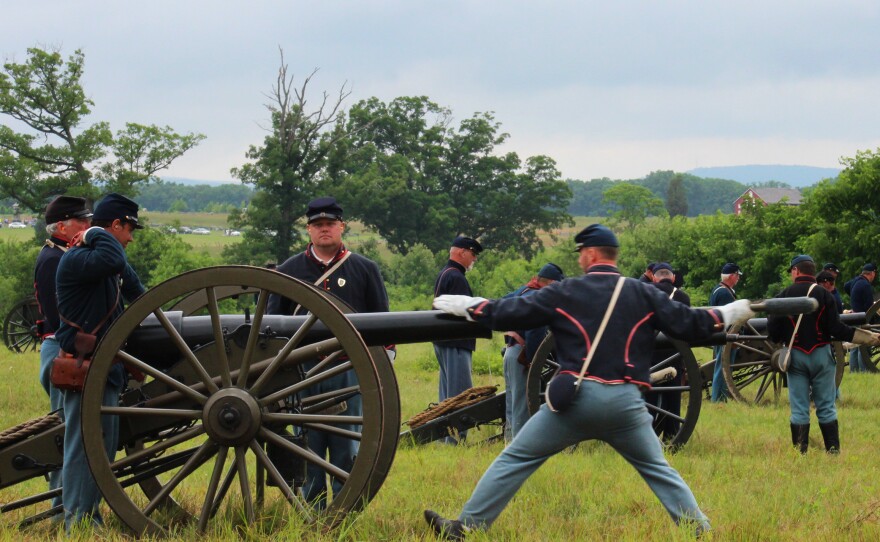







About three dozen men dressed in Confederate Army uniforms woke Wednesday morning on historical campgrounds at the iconic Gettysburg battlefield. Soggy from the night's rain, they warmed themselves by the fire and cooked up bacon and potatoes.
The re-enactors joined hundreds of others camping out to show visitors what life may have been like for Civil War soldiers. It's part of a huge display the National Parks Service is putting on to mark the Battle of Gettysburg's 150th anniversary.
The commemorations have brought thousands of tourists to Pennsylvania's Adams County this week to mark the three-day battle, which began on July 1, 1863.
There are heavy artillery demonstrations and infantry units firing muskets. Pipe and fife bands perform "patriotic airs" to keep the troops in step and serve as alarms to wake the troops in the morning.
Pete Bedrossian, dressed as a solider, is here with at the Union camp. He says he's here to honor those who died in the Civil War's bloodiest battle.
"No one can speak for these people," Bedrossian says. "If we can presume the arrogance to do so, we speak on their behalf."
Imagining A Bloody Battlefield
Mike Litterst, a National Parks Service spokesman, says the battle was far from planned. Confederate troops marching down from Harrisburg ran into a group they thought was militiamen.
"Lo and behold, it was the [Northern] Army of the Potomac and not the Pennsylvania militia," Litterst says. "And quite by accident the Confederate and Union [armies] begin to clash northwest of Gettysburg on the beginning of July 1."
Two days later, Confederate Gen. Robert E. Lee's Army of Northern Virginia was defeated and more than 50,000 soldiers from both sides were dead. Thousands more were wounded.
Just east of the battlefield, at historic Daniel Lady Farm, sparrows have made nests in an old red barn. Members of the 17th Corps Field Hospital group, which specializes in demonstrations of Civil War-era medicine, have taken over the farm. They've set up a mock field hospital here, just as the Confederate Army used the then-abandoned farm in 1863 to treat their wounded.
"Imagine 400 men in here, some of them groaning, some of them dying, some of them with a death rattle ... right next to someone who might have only been slightly wounded," said Trevor Steinbach, who plays the role of a surgeon in the unit.
Steinbach says Civil War battlefield medicine was actually pretty good for the time, except it was missing one crucial thing.
"We didn't know anything about germ theory until we saw the research coming out of Europe in 1866," Steinbach said.
He says most Civil War soldiers actually died of illness compounded by poor nutrition and exposure to the elements. What makes Gettysburg notable is the sheer number who died of battle wounds.
Hoping For A Big Economic Boost
It's not just all re-enactments -- there are ghost tours and horse-drawn buggy rides -- and even opportunities to buy period items. Gettysburg and the surrounding economy expect $100 million from anniversary events.
Of course, hosting all those people can be a challenge. The National Parks Service spent about $500,000 to prepare, on everything from doubling its staff to bringing in extra portable toilets.
"The most important thing that we can do in these 150th-anniversary programs is engage the next generation of stewards for places like Gettysburg," Litterst says.
Warren Stevens was here 50 years ago this week with his parents. Now, at 58, he's back, this time as a re-enactor who hopes to teach a little American history to today's children.
"It's nice to see the kids put down the iPads for a couple hours and see what's in the real world around them," Stevens says.
That world will continue to be on display through the holiday weekend, with more historical demonstrations and re-enactments planned.
Copyright 2013 NPR. To see more, visit www.npr.org.






